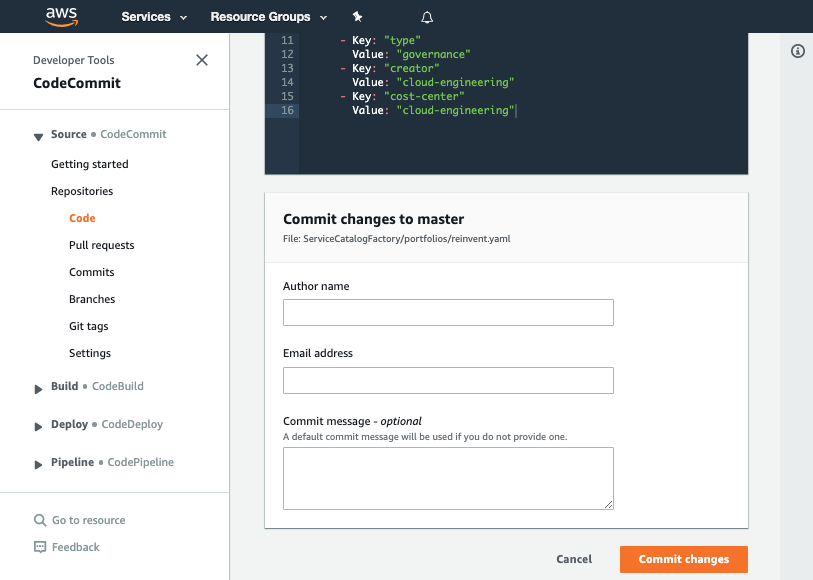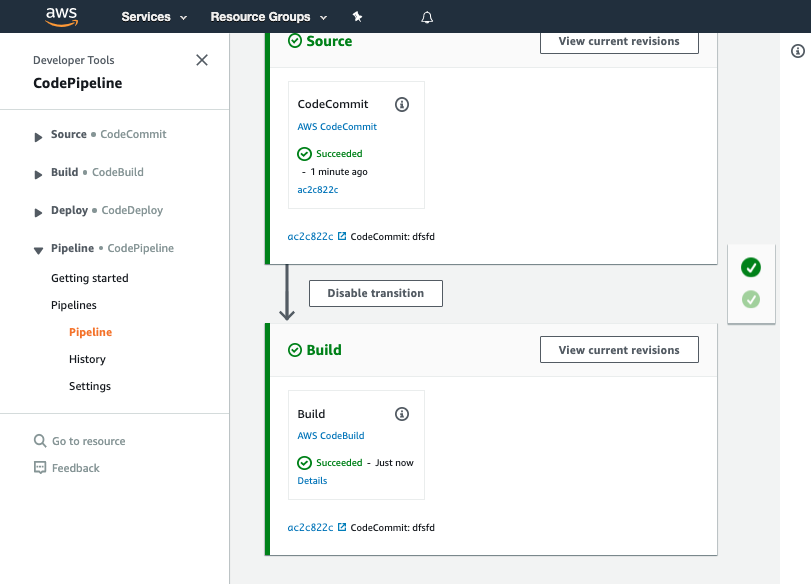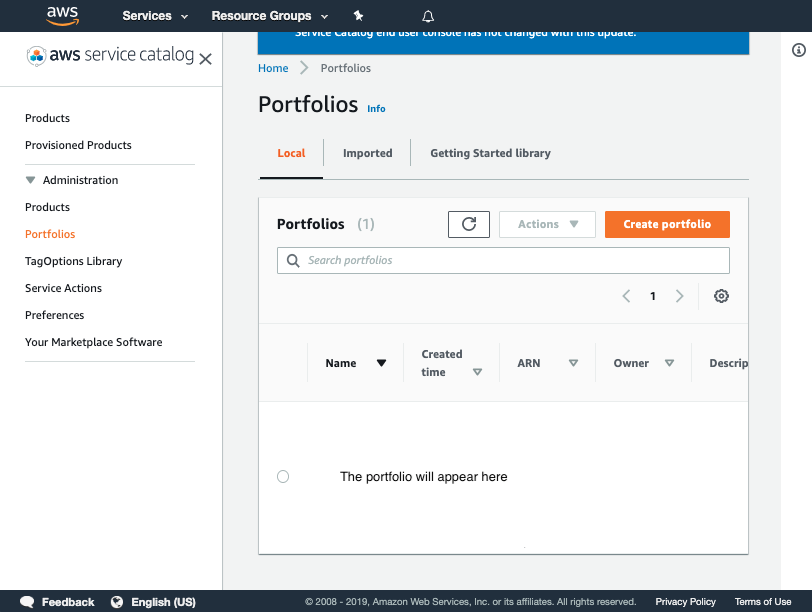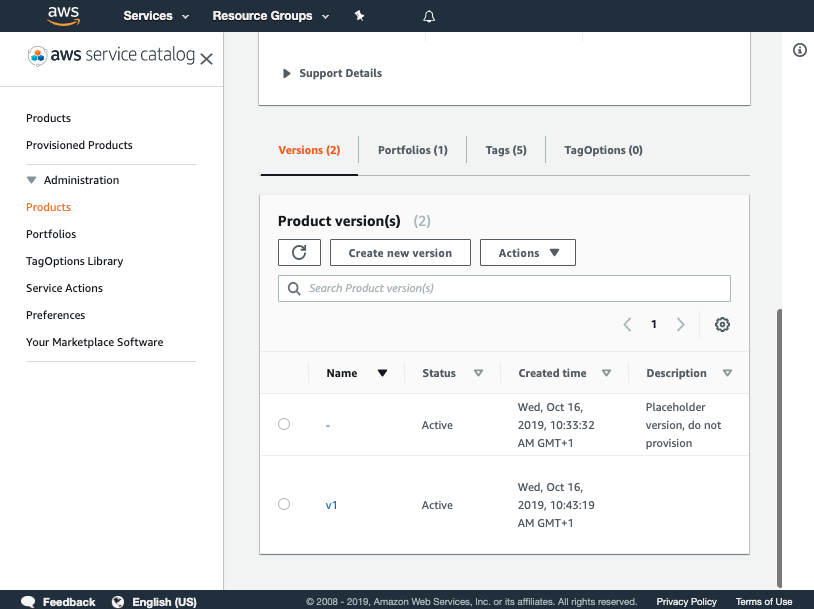Using AWS Service Catalog
What are we going to do?
We are going to perform the following steps:
- Create a portfolio for sharing products
- Share the portfolio networking-optional into a spoke account
Step by step guide
Here are the steps you need to follow to “Using AWS Service Catalog”
Create a portfolio for sharing products
-
Navigate to the ServiceCatalogFactory CodeCommit repository
-
Click on portfolios, then networking.yaml and click “Edit”.
-
Append the following snippet into the portfolios section whilst updating the role name to the one you are using in the associations section:
- DisplayName: "optional" Description: "Portfolio containing the optional networking components" ProviderName: "cloud-engineering" Associations: - "arn:aws:iam::${AWS::AccountId}:role/<INSERT YOUR ROLE NAME HERE>" Tags: - Key: "type" Value: "governance" - Key: "creator" Value: "cloud-engineering" - Key: "cost-center" Value: "governance" -
Add the portfolio of
- "optional"to the portfolios list for subnet product. -
The file should look like the following:
Schema: factory-2019-04-01 Products: - Name: "subnet" Owner: "networking@example.com" Description: "subnet for networking" Distributor: "networking team" SupportDescription: "Speak to networking@example.com about exceptions and speak to cloud-engineering@example.com about implementation issues" SupportEmail: "cloud-engineering@example.com" SupportUrl: "https://wiki.example.com/cloud-engineering/networking/subnet" Tags: - Key: "type" Value: "governance" - Key: "creator" Value: "cloud-engineering" - Key: "cost-center" Value: "governance" Versions: - Name: "v1" Description: "v1 of subnet" Active: True Source: Provider: "CodeCommit" Configuration: RepositoryName: "subnet" BranchName: "main" Portfolios: - "mandatory" - "optional" Portfolios: - DisplayName: "mandatory" Description: "Portfolio containing the mandatory networking components" ProviderName: "cloud-engineering" Associations: - "arn:aws:iam::${AWS::AccountId}:role/<INSERT YOUR ROLE NAME HERE>" Tags: - Key: "type" Value: "governance" - Key: "creator" Value: "cloud-engineering" - Key: "cost-center" Value: "governance" - DisplayName: "optional" Description: "Portfolio containing the optional networking components" ProviderName: "cloud-engineering" Associations: - "arn:aws:iam::${AWS::AccountId}:role/<INSERT YOUR ROLE NAME HERE>" Tags: - Key: "type" Value: "governance" - Key: "creator" Value: "cloud-engineering" - Key: "cost-center" Value: "governance" -
Set your Author name
-
Set your Email address
-
Set your Commit message
Using a good / unique commit message will help you understand what is going on later.
- Click the Commit changes button:

What did we just do?
The YAML file we created in the CodeCommit repository told the framework to create a new portfolio and to add the subnet product to that new portfolio.
Verify the change worked
Once you have made your changes the ServiceCatalogFactory Pipeline should have run. If you were very quick in making the change, the pipeline may still be running. If it has not yet started feel free to the hit the Release change button.
Once it has completed it should show the Source and Build stages in green to indicate they have completed successfully:

Verify the product was added to the portfolio
Now that you have verified the pipeline has run you can go to Service Catalog portfolios to view your portfolio.
- Click on networking-optional

-
Click on the product subnet
-
Click on the version v1

Share the portfolio networking-optional into a spoke account
-
Navigate to the ServiceCatalogPuppet CodeCommit repository again
-
Click on manifest.yaml
-
Click Edit
-
Append the following snippet to the end of the main input field:
spoke-local-portfolios: networking-optional: portfolio: "networking-optional" product_generation_method: copy depends_on: - name: vpc type: stack affinity: stack deploy_to: tags: - tag: "type:prod" regions: "default_region" -
The main input field should look like this (remember to set your account_id):
accounts:
- account_id: "<YOUR_ACCOUNT_ID_WITHOUT_HYPHENS>"
name: "puppet-account"
default_region: "eu-west-1"
regions_enabled:
- "eu-west-1"
tags:
- "type:prod"
- "partition:eu"
stacks:
delete-default-networking-function:
name: "delete-default-networking-function"
version: "v1"
capabilities:
- CAPABILITY_NAMED_IAM
deploy_to:
tags:
- tag: "type:prod"
regions: "default_region"
vpc:
name: "vpc"
version: "v1"
depends_on:
- name: "delete-default-networking"
type: "lambda-invocation"
affinity: "lambda-invocation"
deploy_to:
tags:
- tag: "type:prod"
regions: "default_region"
outputs:
ssm:
- param_name: "/networking/vpc/account-parameters/${AWS::AccountId}/${AWS::Region}/VPCId"
stack_output: VPCId
lambda-invocations:
delete-default-networking:
function_name: DeleteDefaultNetworking
qualifier: $LATEST
invocation_type: Event
depends_on:
- name: "delete-default-networking-function"
type: "stack"
affinity: "stack"
invoke_for:
tags:
- regions: "default_region"
tag: "type:prod"
assertions:
assert-no-default-vpcs:
expected:
source: manifest
config:
value: []
actual:
source: boto3
config:
client: 'ec2'
call: describe_vpcs
arguments: {}
use_paginator: true
filter: Vpcs[?IsDefault==`true`].State
depends_on:
- name: "delete-default-networking"
type: "lambda-invocation"
affinity: "lambda-invocation"
assert_for:
tags:
- regions: regions_enabled
tag: type:prod
launches:
subnet:
portfolio: "networking-mandatory"
product: "subnet"
version: "v1"
depends_on:
- name: vpc
type: stack
affinity: stack
parameters:
VPCID:
ssm:
name: "/networking/vpc/account-parameters/${AWS::AccountId}/${AWS::Region}/VPCId"
SubnetCIDR:
default: '10.0.0.0/24'
deploy_to:
tags:
- tag: "type:prod"
regions: "default_region"
workspaces:
subnet:
name: "subnet"
version: "v1"
depends_on:
- name: vpc
type: stack
affinity: stack
parameters:
VPCID:
ssm:
name: "/networking/vpc/account-parameters/${AWS::AccountId}/${AWS::Region}/VPCId"
SubnetCIDR:
default: '10.0.1.0/24'
deploy_to:
tags:
- tag: "type:prod"
regions: "default_region"
spoke-local-portfolios:
networking-optional:
portfolio: "networking-optional"
product_generation_method: copy
depends_on:
- name: vpc
type: stack
affinity: stack
deploy_to:
tags:
- tag: "type:prod"
regions: "default_region"
Committing the manifest file
- Set your Author name
- Set your Email address
- Set your Commit message
Using a good / unique commit message will help you understand what is going on later.
- Click the Commit changes button:

What did we just do?
The changes we made told the framework to make a portfolio in the default region of each spoke with the tag type:prod. This portfolio will contain copies of the products that exist in the hub account.
Verifying the portfolio share
Once you have made your changes the ServiceCatalogPuppet Pipeline should have run. If you were quick in making the change, the pipeline may still be running. If it has not yet started feel free to the hit the Release change button.
As this workshop has been designed to run in a single region of a single account you cannot verify this step. If the pipeline ran and each stage has succeeded the share should have taken place. When sharing a portfolio with the same account it was created in the framework does not perform any actions.